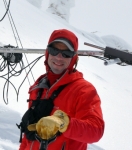Put your shovel in the snow!
This simple act could save your life. Pausing to assemble your shovel and dig a few scoops can sometimes reveal a hidden but, once exposed, obvious weak layer. Taking a few more minutes to perform an Extended Column Test (ECT) may give you strong evidence of unstable slopes. When conditions seem good most people have already made their decision to ski or not by the time they reach the top of a slope, but an ECT might change your mind and save your life. Conversely, if you decide to not ski because of dangerous conditions there is no need to dig. Regardless of experience, if we play in avalanche terrain we should hunt for instability.



